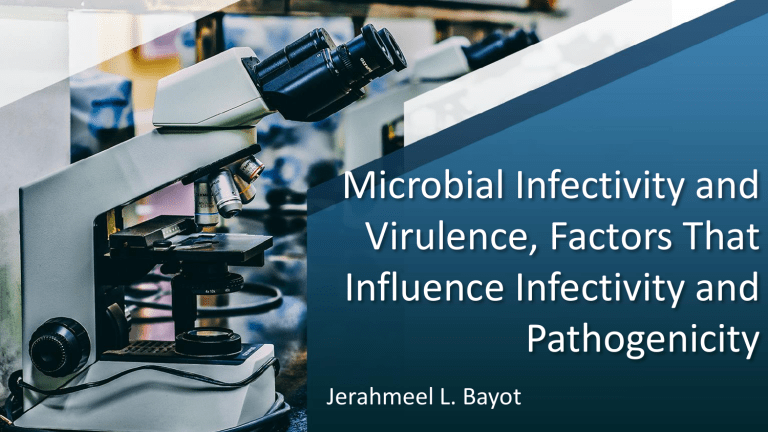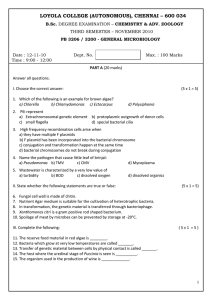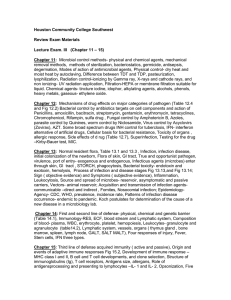
Microbial Infectivity and Virulence, Factors That Influence Infectivity and Pathogenicity Jerahmeel L. Bayot Infectivity is the ability of an infectious agent to cause a new infection in a susceptible host, and in directly transmitted diseases it is measured by the secondary attack rate, which is the proportion of susceptible individuals that develop the infection after exposure to a primary case. Pathogenicity is the capacity of an organism to cause disease. During virus infections, diseases symptoms arise from two causes, direct injury caused by virus replication and the side effects of the immune response to infection. Virulence is an attribute of all pathogenic or disease-producing organisms and usually involves a set of morphologic, biochemical, and functional traits that must be present together for successful infection and disease production - Refers to the disease-producing power or malignancy of an organism. - A highly virulent organism has great malignancy, a slightly virulent one has little, and a non-virulent one has none. Basic Steps in Pathogenesis Continue to Provide a Sound Foundation - - attachment or other means of entry into the body evasion of normal host defenses against infection multiplication to significant numbers at the site of infection and/or spread to other sites damage to the host, either directly or through the non-specific or specific immune host response to the bacterium transmission from the infected animal to other susceptible animals, so that the infection cycle can continue. Pathogen Association with the Host Successful colonization of the skin or a mucosal surface of the host is usually the first pre-requisite of the infectious process. Some organisms need to employ motility and chemotaxis as well as resistance to acid and bile in order to reach their target host cells. Initial contact between bacterial pathogen and host cell is usually mediated by fimbrial or non-fimbrial adhesins on the bacterial surface Factors for adherence with host cells Binding may result either in extracellular colonization or in internalization of the pathogen. The adhesins bind to specific host cell surface receptors, and both host and organ specificity of infection may be determined by differences among animals in cellular, receptors for the bacterial adhesins. For example, the Listeria monocytogenes adhesion molecule internalin A (InlA) promotes uptake of the bacterium into intestinal epithelial cells by binding to E - cadherin. InlA binds to human and rabbit E - cadherin and causes disease in these species; however, it fails to bind to mouse E cadherin and so does not cause disease in mice. Fimbriae (or pili) are rod like or fibrillar surface appendages on bacteria which mediate attachment to host tissues. Each fimbrial unit consists of hundreds of copies of a major subunit which provides the structure and confers the antigenic specificity of the fimbriae. Fimbriae may also contain several copies of minor subunits, one of which may be an adhesin with specific binding properties. Capsule or biofilm provides increased protection of bacteria from antibiotics and host defenses. Some capsules mimic host matrices so that the organisms are unrecognized by phagocytes • Bacterial pathogens, including those associated with wound infections, may bind to extracellular matrix molecules such as fibronectin, collagen, laminin, or other proteins possessing RGD (Arg - Gly - Asp) sequences for binding of eukaryotic cell membrane integrins. Bacteria may use “ invasins ” to mediate their uptake into nonprofessional phagocytic host cells after attaching to molecules on the cell surface and activating host cell signaling to facilitate their entry, often through host cell cytoskeletal rearrangement The outer membrane protein invasin produced by these bacteria binds to β 1 integrin on the surface of M cells and triggers uptake of the bacteria in a zipper - like internalization process. This entry provides the bacteria with access to the lymphoid tissue below, and to draining lymph nodes, in which the bacteria are well equipped to multiply. This entry provides the bacteria with access to the lymphoid tissue below, and to draining lymph nodes, in which the bacteria are well equipped to multiply. Pathogen Multiplication and Evasion of Host Defenses After initial association with the host, bacterial pathogens need to evade host defenses and to multiply to numbers sufficient for the infection to be self - sustaining rather than to be aborted by the host response. The “ defensins ” involved in the evasion – multiplication process can be divided into those involved in defense against innate immune mechanisms and those involved in defense against specific immune mechanisms. Adhesion and Penetration of Epithelial Barriers Epithelial barriers constitute a very basic form of immune defense, and most species of pathogenic bacteria have mechanisms to breach these defenses. These mechanisms include recognized adhesins binding host cell receptors or host cell extracellular matrix, fimbriae, type III secretion systems that inject bacterial proteins into host cells to act as receptors, or uptake by means of M cells overlying Peyer ’s patches in the intestine The bacteria having the type III secretion system on contact with cells, delivers proteins into the cells which cause polymerization and depolymerization of actin filaments resulting in cytoskeletal rearrangement. Pathogen Damage to the Host The Ability to Compete for Nutrients and Iron -Bacteria compete for nutrients by synthesizing specific transport systems or cell wall components capable of binding limiting substrates and transporting them into the cell. -Bacterial damage to the host is usually essential for immediate or long term acquisition of the nutrients that the bacterium needs to thrive and to continue its pathogenic lifestyle. Infection does not always lead to disease, which is only one of the possible outcomes of bacteria – host interaction. Pathogen Transmission from the Host Although not often considered in a discussion of bacterial pathogenesis, a crucial feature of bacterial pathogens is their ability to use their pathogenic nature to ensure their further transmission from the host, either back into their environmental reservoir or directly to other susceptible hosts. Depending on the infection, further transmission to animals may be immediate or may even involve decades.




